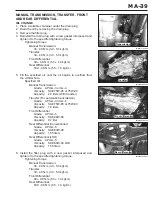
INSPECTION OF WHEEL CYLINDER FOR LEAKAGE
1.
Jack up the vehicle and support it with safety stands.
(Refer to the GI section.)
2.
Remove the wheels.
3.
Release the parking brake fully.
4.
Remove the rear brake drum from the rear axle hub by
pulling it out.
NOTE:
·
If any difficulty is encountered in removing the brake
drum, screw in the 8 mm bolts to the brake drum even-
ly.
·
The bolt hole is of the offset type. Therefore, after tight-
ening the bolt to a certain extent, make the brake drum
float evenly by lightly tapping the brake drum with a
plastic hammer or the like.
5. Ensure that no damage exists on the brake shoe lining
surfaces.
If any damage is found, replace the brake shoes with new
ones.
(Refer to the BR section.)
CAUTION :
·
Replacement should be performed for the right and left
side shoes as a set.
6. Ensure that no brake fluid leakage exists around the wheel
cylinder boots.
Replace the piston cups and cylinder boots if brake fluid
leakage exists.
(Refer to the BR section.)
7. Clean the attaching surface of the brake drum and rear
axle hub.
8. Install the brake drum on the rear axle hub.
9. Clean the attaching surface of the brake drums and
wheels.
10. Install the wheels and tighten the attaching bolts to the
specified tightening torque.
Tightening Torque:
103.0
±
14.7 N·m
(10.5
±
1.5 kgf-m)
11. Apply the brake pedal fully several times until the clicking
sound is emitted.
12. Ensure that the brake drum turns lightly without being
caught.
13. Check effectiveness of the rear brake with a brake tester.
MA–33
JMA00093-00073
JMA00094-00074
JMA00095-00000
JMA00096-00075











































